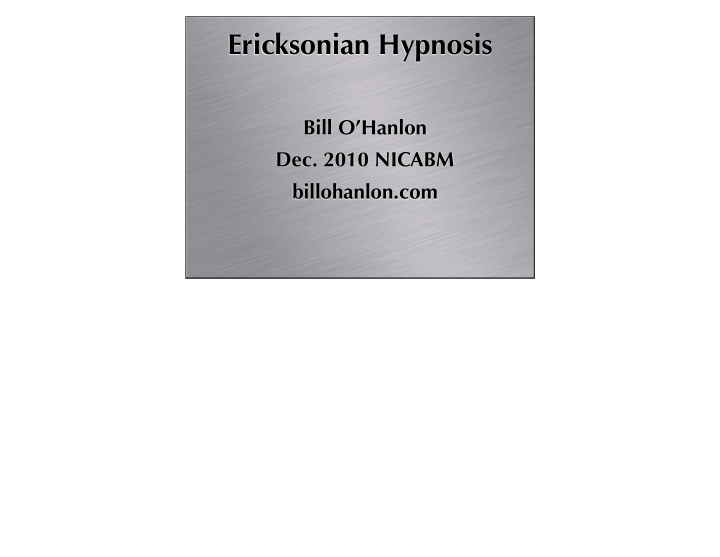



Ericksonian Hypnosis Bill O’Hanlon Dec. 2010 NICABM billohanlon.com
ERICKSONIAN VS. TRADITIONAL PERMISSIVE VS. AUTHORITARIAN
PERMISSIVE Could, might, can, okay to, may Multiple options, choices
AUTHORITARIAN Predictions: Will, going to, won’t Mind-reading: Are Instructions: Must; Can’t; particular feelings, actions, directions
ZORAN SAYS YOU WILL
ERICKSONIAN VS. TRADITIONAL EVOCATIVE VS. SUGGESTIVE
ERICKSONIAN VS. TRADITIONAL EXPERT VS. COLLABORATIVE
Different approaches Traditional Ericksonian Searches for causes of Discover/connect w/ problems resources Discover hidden/non- conscious original trauma or Present- or future-oriented decision Assumption of resources and Assumption of pathology abilities
Elements ! of ! Induction ! #1 Permission ! and ! Inclusion
Elements ! of ! Induction ! #2 Presupposition
Elements ! of ! Induction ! #3 Splitting
Elements ! of ! Induction ! #4 Linking
I AM GOING to a place where there are no bad MAD people.
Elements ! of ! Induction ! #5 Interspersal [Embedded ! messages]
Other Elements Description Truisms Matching Guiding attention and associations The confusion technique
The Confusion Technique Two pairs of opposites Mix ‘n’ match them until the person can no longer follow rationally and logically
Trance language Use vague and abstract words Use nouns from verbs Use passive language (no willful actions implied) The person as witness or experiencer rather than conscious creator
Common Trance Indicators
Four Doorways Into Altered States Rhythm Defocusing Focusing Dissociation
Trance Phenomena Getting one’s hand on the control knob on non-voluntary experience Inviting alterations in: • Perception • Sensations • Memory • Time orientation • Spatial orientation • Physiology
WHY USE TRANCE PHENOMENA? To evoke automatic changes To convince you and/or the person that they are in trance To evoke resources As an analogy for the therapeutic changes you are after
HOW TO EVOKE/INVITE TRANCE PHENOMENA General permission Presupposing Remind and evoke previous everyday experiences Analogies/anecdotes Emphasized words/phrases
The Unconscious Erickson maintained that the unconscious is smart, wise and benevolent “Trust your unconscious,” he would say If the unconscious is so smart, why do people have problems or symptoms?
The Answer The unconscious is smart about what it is smart about Dumb about what it is dumb about And sometimes, the unconscious is smart about something it is dumb to be smart about
How to use this notion to do trancework Find the place where automatic patterns occur and lead to unwanted results Introduce changes to the pattern by evoking, altering, splitting and linking
When to use trance Voluntary/deliberate experiences vs. Non-voluntary/out of conscious control experiences
Class of Problems/ Class of Solutions Presenting problem Intervention Link to problem context Generate the opposite Class of problem Class of Solutions
Class of Problems/ Class of Solutions Find a clear focus/problem Turn problems into processes How does or would a person or body or neurology DO this problem? What class of problems could it belong to? What is the opposite class (or set of resources or abilities) that could resolve the problem?
Classes of Solutions: Pain Anesthesia/analgesia Amnesia Dissociation of parts of the body Re-interpretation Time distortion Altering physiological processes Re-evoking previous pain-free or pain-incompatible experiences Distraction or absorption of attention Displacement Compelling connection to a future without pain
How to evoke automatic shifts with hypnosis Tell stories Guide associations Remind people of previous experiences Emphasize phrases and words Presuppose and create expectations
Hand Levitation Evoke everyday experiences of automatic hand/arm/muscle movement Use analogies/anecdotes/stories Use general permissive statements Use presupposition Once you see a response, amplify and direct/ link it to something more
How to tell an evocative story Characters Actions Beginnings, middles and ends Settings and props Dialogue Vague enough to allow for identification and imagination Enough specific details (names, places, actions, sensory details, etc.) Engagement of interest/suspense Repetition of phrases, sounds or elements
INCLUSION The permissive approach as treatment in itself Giving people permission to include and value missing aspects of experience and self Countering devalued, neglected, dissociated and disowned aspects and experiences
3 Levels of Inclusion Permission To and Not to Have to Inclusion of Opposites Exceptions
Methods of Inclusion Tag questions Apposition of opposites Link resistance or undermining to certain locations, times or aspects of the person
Symptom Trance/ Healing Trance Symptoms and problems as “bad trance” The difference between bad trance and good trance Waking people from trance Shifting from bad trance to good trance
SELF HYPNOSIS Arguments for and against Making recordings Methods The natural way Defocusing attention The rhythm method Focusing attention
Bill O’Hanlon www.billohanlon.com www.publishabook.com www.paidpublicspeaker.com www.yourlifeoffreedom.com www.getovertrauma.com 223 N. Guadalupe #278, Santa Fe, NM Bill@billohanlon.com
Recommend
More recommend